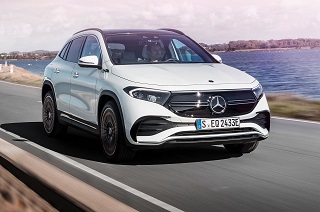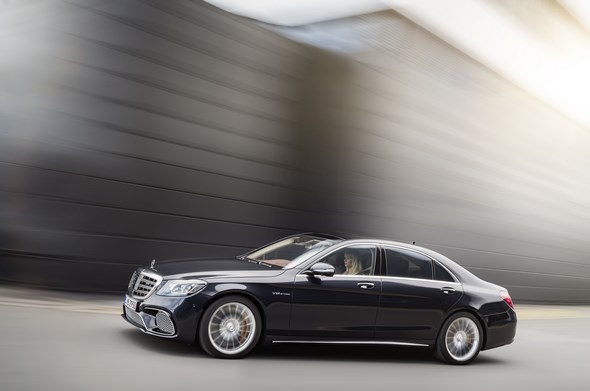Mercedes-Benz GLE family from 45,350 euros

The relaunch of a best-selling SUV
Stuttgart. Compared with its predecessor, the new GLE starts at similar prices but with an enhanced level of equipment.
Customers can order the bestseller from the Mercedes-Benz range of SUVs from 45,350 euros*. Deliveries commence in August.
The highlights of the new GLE include redesigned front and tail ends and extensive measures which make new benchmarks possible with regard to emissions and drive system.
Across the available engine range, fuel consumption and CO2 emissions are reduced by 17 percent on average compared with the preceding series.
For the first time in its SUV history, Mercedes-Benz offers a plug‑in hybrid model, the GLE 500 e 4MATIC, which combines maximum energy efficiency with outstanding performance.
This will even best the already low fuel consumption figures of the GLE 250 d, an efficiency champion with four-cylinder diesel engine, while delivering the performance of the GLE 500 4MATIC V8 model.
The pricing structure for the GLE 500 e 4MATIC is also attractive with the plug-in hybrid available from 62,100 euros*.
For customers for whom performance is particularly important, for the first time there are two output levels for this high-performance SUV courtesy of the Mercedes-AMG GLE 63 4MATIC and GLE 63 S 4MATIC models. Prices here start from 93,600 euros*.
At 45,350 euros*, the GLE 250 d base model with rear-wheel drive costs 1900 euros less than the previous entry-level model for this series.
The two other diesel models, the GLE 250 d 4MATIC and the GLE 350 d 4MATIC, have a more attractive specification at around the same price level as before.
The V6 and V8 petrol variants, the GLE 400 4MATIC and the GLE 500 4MATIC, also offer this price stability when taking equipment into account. This also applies to the Mercedes‑AMG GLE 63 4MATIC.
Prices at a glance**:
| Net price | Gross price | |
| GLE 250 d 150 kW (204 hp) | €45,350.00 | €53,966.50 |
| GLE 250 d 4MATIC 150 kW (204 hp) | €47,650.00 | €56,703.50 |
| GLE 350 d 4MATIC 190 kW (258 hp) | €51,050.00 | €60,749.50 |
| GLE 400 4MATIC 245 kW (333 hp) | €51,200.00 | €60,928.00 |
| GLE 500 e 4MATIC 245+85 kW (333+166 hp) System output 325 kW (442 hp) | €62,100.00 | €73,899.00 |
| GLE 500 4MATIC 320 kW (435 hp) | €64,600.00 | €76,874.00 |
| Mercedes-AMG GLE 63 4MATIC 410 kW (557 hp) | €93,600.00 | €111,384.00 |
| Mercedes-AMG GLE 63 S 4MATIC 430 kW (585 hp) | €101,900.00 | €121,261.00 |
** Prices for the German market
Complete standard equipment, attractive equipment packages
The extensive range of standard equipment for the new GLE is based on the successful predecessor model, enhanced with new assistance systems such as Crosswind Assist and COLLISION PREVENTION ASSIST PLUS. An ECO start/stop function, the DYNAMIC SELECT controller on the centre console, the revised multifunction steering wheel as well as the Audio 20 CD infotainment system with new, semi-integrated media display and communications module for the use of Mercedes connect me services are also part of the standard delivery scope. Both diesel models come with the compelling 9G-TRONIC nine-speed automatic transmission.
This high equipment level as standard can be upgraded further with attractive equipment packages. The Driving Assistance package Plus includes DISTRONIC PLUS with Steering Assist and Stop&Go Pilot, PRE-SAFE® Brake with pedestrian detection, BAS PLUS with Cross-Traffic Assist, Active Blind Spot Assist, Active Lane Keeping Assist and PRE-SAFE® PLUS. The Parking package with 360° camera and Active Parking Assist with PARKTRONIC guarantees an excellent overview and problem-free manoeuvring into and out of parking spaces.
Freely combinable packages lend the GLE additional appeal. With the AMG Line exterior, the GLE has a more dynamic and athletic appearance. This package comprises, among other things, front and rear aprons in the distinctive AMG bodystyling and 50.8-cm (20-inch) AMG alloy wheels. Those who like things even more exclusive can combine this feature with the Night package, which features high-gloss black for the radiator grille louvres, exterior mirror housings and window weatherstrips, for example. The line-up of options is rounded out by high-sheen black 50.8-cm (20-inch) AMG alloy wheels.
The AMG Line interior transfers the sporty appearance inside with sports seats with ARTICO man-made leather upholstery (optional nappa leather), a black nappa leather multifunction sports steering wheel, an instrument cluster with distinct dial in chequered-flag design and brushed stainless steel sports pedals.
Mercedes-AMG GLE 63 and GLE 63 S: high-performance equipment
The two Mercedes-AMG versions, the GLE 63 4MATIC and the GLE 63 S 4MATIC, offer even higher quality and exclusivity. Exquisite materials, first-class workmanship and maximum precision in the interior create a unique ambience. Aluminium trim parts with longitudinal grain in the black ARTICO man-made leather instrument panel create attractive highlights. Perforated nappa leather sports seats with special upholstery layout and topstitching as well as AMG badges make for an exclusive look and feel. The fitting complement is the 3-spoke AMG Performance steering wheel with flattened bottom section and shift paddles in silver aluminium. Two tube-shaped round dials with silver chrome surrounds and the central 11.4-cm (4.4-inch) multifunction display provide the driver with comprehensive information. The typical AMG equipment scope includes sporty dials in carbon-fibre look with 320-km/h speedometer scale, AMG lettering and red pointers, as well as the main menu including RACETIMER, manual gear indicator and AMG start-up screen. The Mercedes-AMG GLE 63 S model offers nappa leather exclusive AMG upholstery in addition – a highlight both in terms of looks and touch and feel.
Customers with the AMG model also have the opportunity to personalise their vehicle with components from the AMG Performance Studio. The choice ranges from a carbon-fibre engine cover or various alloy wheels to the Performance steering wheel and the Performance exhaust system with its emphasis on sporty sound.





